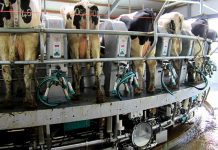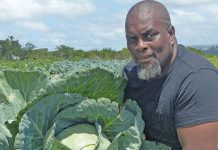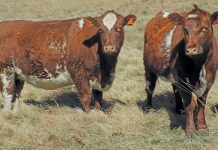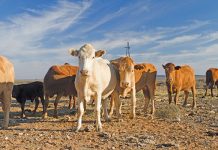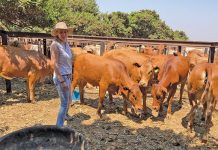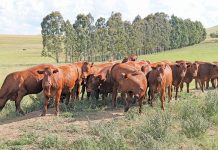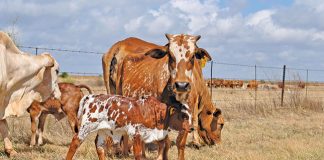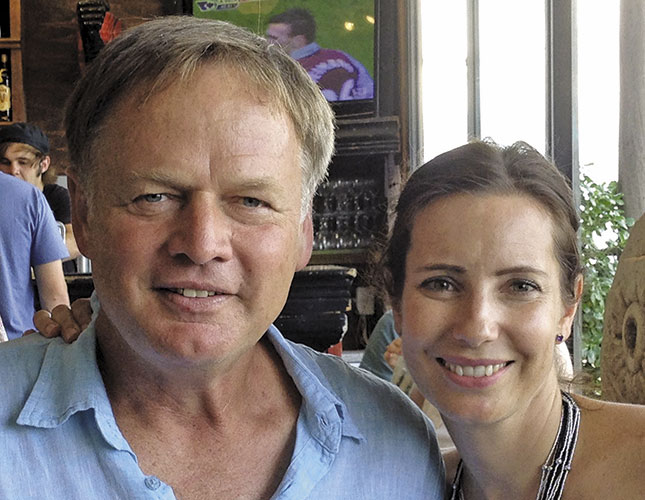
A smooth-running operation, an impeccable reputation, and genetics sought-after by breeders worldwide; Philip and Vicky Barnard, of the Clocolan district, have all this, but not by accident. The Barnards are at the top of their game, constantly building on and improving Philip’s legacy. His father, Willem Barnard, established the stud in 1967. Today, Philip and Vicky work closely together to run the Mequatling herd on 1 000ha planted pasture, 500ha cropland and 2 000ha veld.
“We try to be the best at what we’re doing, and because we enjoy it so much, things seem easier,” says Vicky. “Philip involved me in the farming and then taught and encouraged me. I’ve learnt so much from him.” The Barnards run 350 registered red and black female cows, 150 embryo recipient cows and 600 commercial female cows. “Our intention is always to provide excellent Angus genetics to stud breeders and commercial cattlemen, so that SA consumers can enjoy top quality beef as cheaply as possible,” says Philip.
Mequatling pioneered the sale of SA Angus embryos to North and South American countries and to Europe. At the 2005 World Angus Forum Embryo Auction, their product was at the top of the log, beating offerings from North America, South America, Europe and Australasia. The Mequatling herd is the leading SA performance-testing Angus herd and accounts for 21% of all official Angus phase D and C growth test data, 65,6% of all carcass scanning test data and 32,9% of all Angus DNA on record at Unistel.
“Mequatling females calve at 23 months with an average 371-day intercalving period and maintain a reproduction index of 124. To maintain the integrity of information, stud animals are DNA-tested to guarantee pedigree and performance,” explains Philip. This means that Philip and Vicky are getting heifers in calf at 14 months. They are utilising the fertility of the breed to the maximum, with excellent nutrition and top-class management. “Philip never gives me a heifer under 350kg to inseminate,” says Vicky.
Their bulls are tested for growth, scanned for carcass quality and measured for frame score. “I go for proven, measured facts rather than opinions,” Philip stresses.
Management
“The cattle get a phosphate lick in summer, a protein lick in winter, and a production lick a month pre-calving and two months post-calving,” he explains. “The females calve unassisted every year, wean at more than 48% of cow weight, convert feed at a ratio of below 5:1, gain at least 2kg daily and have superior quality carcasses. “Gall sickness is endemic to the Clocolan area, but we maintain resistance by allowing a moderate tick presence and only dipping when the parasite load gets too high.”
Their bulls are fertility-tested and checked for trich and vibrio. Apart from the mandatory vaccinations, the animals are inoculated against Rift Valley fever, anthrax, black quarter and lumpy skin with Bovishield 4 and One Shot Ultra 7. “We run the cattle in 30ha to 50ha camps at a stocking rate of 3ha/MLU. The official carrying capacity is 5ha/ MLU on grassveld, but pasture allows us to increase this substantially,” says Philip.
The pastures are mainly Smuts fingergrass (Digitaria eriantha) and Eragrostis curvula with some tall fescue (Festuca arundinacea) and lespedeza. “We focus fully on beef production, and other divisions of our operation, such as maize production, contribute to this,” says Philip.
Production sale
Mequatling stud animals are marketed at the Barnard’s annual production sale, which is planned for 24 July this year. Every pregnant, six-year-old registered cow is put up for auction. These have calved at two years and annually after that with a reproduction index of above 100.
Only the top 30% to 35% of bulls are put on auction. This means that the Barnards present only the top-of- the-range bull crop for sale. To do this, they are culling more heavily than would be done elsewhere in the world. It also means that they do not sell any sub-standard bulls. Bulls are put through Phase D testing and measured for frame score, then carcass- tested with RTU (real time ultrasound) scanning. Mequatling animals do not carry genetic disorders such as osteopetrosis (marble bone disease) and curly calf syndrome.
About 100 pregnant commercial heifers – all inspected and approved by SA Angus breed director John Boulle – are on offer at the Barnard’s production sale. The event is attended by buyers from South Africa and from neighbouring countries. Averages at last year’s sale were high, with 28 cows averaging R31 857, and 48 bulls averaging R43 313. Mequatling Chief Warhawk’s (WB 01-312) straws sold for R875 each and straws from Mequatling Fort Knox (WB 07-168) sold for R1 150 each.
Breeding
The stud mates approximately 350 stud females a year, of which 100 are heifers. About 80% of stud females are artificially inseminated, virtually all by Vicky, who gets up early to do the heat-spotting and AI before breakfast. “We practise natural heat spotting so we have to take it very seriously,” she says. Philip adds: “Mequatling has for many years had over 80% of the Angus breed’s trait-leading dams for combined maternal performance. These are the dams of the Mequatling bulls. They have breed-leading growth and maternal genetics, while maintaining respectable calving ease.”
The Barnards follow a single summer breeding season, inseminating in November and December. “To clean up after AI, we have number of good bulls. Sometimes we buy from fellow SA Angus breeders,” says Philip. “Our cows calve in August, September and October to benefit from the spring flush for optimum calf rearing and re-breeding for the next season.”
The use of modern technology goes hand-in-hand with embryo transfers, and when properly used, allows breeders to identify top genetics in their herds and progress past fellow breeders. It is an important factor in the Mequatling breeding programme. Dr Robert Treadwell of Embryo Plus does the embryo work at Mequatling, achieving a 73,7% conception rate. The stud herd has about 150 embryo recipients, with about 100 to 120 embryos transplanted annually.
Better beef
Carcass selection criteria aim to improve beef marbling and increase slaughter percentage. In 2000, the stud was part of the pioneering Angus real-time-ultrasound (RTU) team to improve carcass quality. To date, Mequatling has RTU-tested 933 animals. Philip and Vicky strongly support the Certified South African Angus Beef (CSAAB) programme.
“Certified SA Angus Beef is available at most Pick n Pay supermarkets and at certain restaurants. We are one of the largest suppliers of calves to the programme,” says Philip. “My husband has a remarkable talent for farming,” says Vicky. “We can rely on each other.”
Contact Mequatling on 082 577 2075 or email [email protected]

